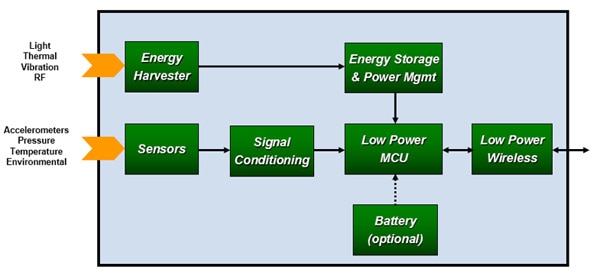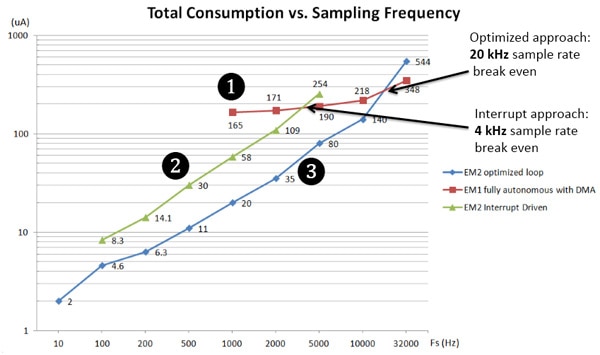Low-Power MCUs for Energy-Harvesting Applications
投稿人:电子产品
2015-03-18
Harvested energy as a power source has been talked about and even practiced on a small scale for years. Only relatively recently have some key electronic components – MCUs and RF transceivers, in particular – reached a stage of development in which the power they consume corresponds to the limited power available from harvesting technologies.
The search for mainstream energy-harvesting solutions has also been accelerated by the arrival of a “killer app” – remote sensor nodes that are an indispensable element of the Internet of Things (IoT). Although these nodes can be complex designs, they all have four components in common – an MCU, a sensor, a harvester, and an RF transceiver. Sensor nodes need an energy source but it is often impractical to connect them to the power grid. Similarly, changing standard alkaline batteries on a regular basis is perceived to be a prohibitive labor cost because the nodes are often widely distributed.
Energy storage is usually part of the system as well because in most cases the small amount of energy harvested must be stored and used when it is needed. This adds a rechargeable battery to the system. Other common components include a power management chip, and signal-conditioning circuits that at the very least handle analog-to-digital (ADC) data conversion. A typical sensor system powered by harvested energy is shown in Figure 1.

Figure 1: Energy-harvesting sensor node. (Courtesy of Silicon Labs)
Before considering a few of the more important design aspects of these systems, it is worthwhile to have some idea of how much energy can be made available by the various forms of harvesting.
Candidates can be divided into four main categories: Vibration, temperature differential, light, and RF. As shown in Figure 2, ambient outdoor light (solar) and vibrating industrial machinery offer an advantage of about three orders of magnitude over the other sources – but not all applications require that much energy.
| Energy Source | Harvested Power |
| Vibration/Motion | |
| Human | 4 μW/cm² |
| Industry | 100 μW/cm² |
| Temperature Difference | |
| Human | 25 μW/cm² |
| Industry | 1-10 mW/cm² |
| Light | |
| Indoor | 10 μW/cm² |
| Outdoor | 10 mW/cm² |
| RF | |
| GSM | 0.1 μW/cm² |
| Wi-Fi | 0.001 μW/cm² |
Figure 2: Energy-harvesting sources. (Courtesy of Texas Instruments)
Despite their differences, photovoltaic, motion, and thermal harvesting have a couple of things in common: They generate erratic voltages instead of the steady 3.3 V or 1.8 V design engineers sometimes take for granted; and they provide intermittent power (sometimes no power at all), which is the reason for including the rechargeable battery.
Design considerations
No fewer than five chip companies with MCU product lines have created energy-harvesting solutions. They include: Texas Instruments, STMicroelectronics, Silicon Labs, NXP Semiconductors, and Microchip Technology. Typically, they offer some combination of their own MCUs, sensors, transceivers, and analog chips but partner with third-party technology companies for the energy harvester.
From the design perspective, the first step is to select components that will meet the application’s power goals. Key considerations include: an extremely-low standby current; very-low active-power consumption; and the ability to switch between active and standby modes extremely quickly.
The value of being able to switch quickly between active and standby modes is not immediately obvious, but it can have a profound effect on energy consumption because energy is basically wasted while the device transitions from standby to active mode.
Energy consumed during data acquisition is an important consideration in sensor systems. If the application requires significant processing power – a health monitoring device, for example – MCUs based on one of the ARM Cortex-M cores are an obvious choice. These 32-bit MCUs can actually be very power efficient because the cores have functions and instruction set features that engineers can leverage relatively easily. For ultra-low-power applications, the Cortex-M Energy Mode 2 (EM2) and the Wait-for-Event (WFE) instruction are particularly useful.
WFE is almost self-explanatory. Instead of continuously polling, the CPU waits for a specific event to occur. ARM includes the WFE instruction in the Cortex-M instruction set.
The EM2 deep-sleep mode enables the MCU to provide a high degree of autonomous operation while keeping energy consumption low. The core’s high-frequency oscillator is turned off but low-energy peripherals can continue to access a 32 kHz oscillator and the real-time clock. Under these conditions, the CPU is not running – so the MCU actually performs advanced operations in sleep mode. Power consumption in EM2 is 0.9 µA.
Let’s look at Cortex-M-based options for data acquisition.
ARM Cortex-M features
The conventional approach to data acquisition is to trigger ADC captures with a timer and transfer the data over the DMA bus. Using Silicon Labs’ Wonder Gecko EFM32WG230F256-QFN64 as an example, one can expect current consumption to be 165 µA at an acquisition rate of 1 K samples/s and 350 µA for 32 K samples/s. While this technique makes good use of peripheral interaction, it does not use any special MCU or instruction set features. The results are shown graphically over a range of acquisition rates by the red line in Figure 3.
The second option (identified as the green line in Figure 3) reduces energy consumption by utilizing EM2 to keep the MCU in standby until an interrupt wakes it up. The interrupt could be triggered by any number of events, including a special timer that operates while the core is in EM2 mode. This feature enables the MCU to get back to full-speed operation in just 2 µs. The MCU draws a standby current of 0.9 µA in EM2 mode. This optimizes the time spent in ultra-low-power mode and reduces the current requirement at 1 K samples/s acquisition to 60 µA – a significant improvement over option one. This technique is suitable for interrupt-driven applications, but depending upon specific circumstances there are additional opportunities to reduce energy consumption.
EM2 is still used in the third option (blue line in Figure 3) – but instead of waiting for an interrupt, it uses the Cortex-M instruction set’s Wait for Event (WFE) instruction. WFE enables the MCU to respond to an external or internal event such as those generated by an interrupt. Instead of making the transition from the main loop into an interrupt, however, the MCU wakes up from EM2 and simply executes the next instruction, which removes interrupt latency. This approach is not appropriate for all applications. However, when it can be used power consumption falls to less than 20 µA to achieve the 1 K samples/s data acquisition rate.

Figure 3: Current consumption vs. sampling frequency. (Courtesy of Silicon Labs)
When the three options are considered over the range of sampling rates as shown in Figure 3, an interesting result is observed. There are crossover points when the conventional first option actually produces better results than the two energy-saving options. In the case of the interrupt approach (option 2) the crossover occurs at a 4 KHz sample rate. In the case of the WFE approach, the crossover is at a 20 kHz sample rate. It should also be noted that most applications that are feasible with energy harvesting, the data acquisition rate is quite low.
Mixed-signal MCUs
MCUs based on the 32-bit ARM Cortex-M cores are, of course, not the only option for energy-harvesting applications. Many can be successfully implemented with 8- and 16-bit MCUs that are often more familiar to embedded-design engineers as well as being less expensive.
Silicon Labs 8-bit C8051F9xx ultra-low-power 8-bit MCU family and Microchip Technology’s eXtreme Low Power (XLP) family of 16-bit MCUs are tuned for ultra-low-power performance. It is difficult to make direct performance comparisons because companies typically use different procedures and assumptions to arrive at performance metrics. Nevertheless, both companies offer parts with sleep currents down to as low as about 10 µA, impressive active power performance, and features such as fast transitions from sleep to active states.
When it comes to tailoring power consumption to the energy available from harvesting solutions, communications is just as important as the MCU. A few MCU vendors are integrating RF functionality on-chip. Microchip offers a range of MCUs with integrated solutions that operate in the unlicensed ISM bands from 310 to 930 MHz. The most versatile is the PIC12LF1840T39A, which operates in four sub bands: 310, 433, 868, and 915 MHz.
Silicon Labs’ Si10xx wireless MCU family also combines an ultra-low-power MCU with a sub-GHz RF transceiver. The family address the specific requirements of low-power embedded systems requiring an RF bidirectional communication link such as sensor nodes. Both a high-performance power amplifier and low-noise amplifier are integrated on-chip. The link budget is 146 dB.
Texas Instruments has also fielded wireless MCUs that communicate in the sub-gigahertz ISM bands. The CC430F513x series, for example, combines TI’s CC1101 sub-1-GHz RF transceiver with its 16-bit MSP430 CPUXV2 core, up to 32 KB of in-system programmable flash memory, up to 4 KB of RAM and other functions, including a 12-bit ADC with six external inputs. It operates in the same four sub bands: 310, 433, 868, and 915 MHz.
While sub-gigahertz solutions are probably the most appropriate for IoT applications, Bluetooth and other standards-based options are available. Most companies also provide proprietary integrated solutions under branding names such as MiWi (Microchip), SimpleLink (Texas Instruments), and EZRadio (Silicon Labs).
Energy storage
Energy-harvesting applications can use solid-state batteries as a backup source of energy when the energy available from the harvester does not meet the immediate power requirements of the rest of the system.
Cymbet is among the companies offering these solutions. Its EnerChip rechargeable solid-state smart batteries (SSBs) can store energy from most types of harvesters. Packaged using surface-mount technology (SMT), the devices can deliver backup power ranging from a few hours to several weeks depending on the stand-by current requirements of the system.
To familiarize designers with its rechargeable solid-state batteries (which feature power-fail detect and automatic switchover) the company has an EnerChip RTC Evaluation Kit that combines a CBC34123 EnerChip RTC, an NXP PCF2123 Real-Time Clock (RTC), a power-management circuit, and solid-state rechargeable EnerChip that can provide up to 30 hours of backup power to the RTC. The combined solution occupies only 0.25 cm2 of board space.
The kit’s PC-based software application communicates via a USB stick. Users can set the time of day, date, and countdown timer values to experiment with RTC power backup. The application also allows the user access to the RTC registers for viewing and modification.
The company has partnered with several MCU vendors, including Renesas, Texas Instruments, and Microchip Technology to create complete energy-harvesting solutions.
Microchip’s XLP 16-bit Energy Harvesting Development Kit, for example, is a representative development platform for realizing energy-harvesting applications. It is based on Microchip’s PIC MCUs with nanoWatt XLP Technology. Power is supplied by Cymbet’s Solar Energy Harvester, which includes a high-efficiency solar panel suitable for use with indoor or outdoor light. The harvester captures, manages, and stores energy in two EnerChips, which in turn supply energy to the XLP development board when light is not available.
Conclusion
The confluence of ultra-low-power chips, viable energy-harvesting solutions, high-density energy-storage technologies and the stringent power requirements of wireless sensor nodes has created a large design space for systems that depend on harvested energy to operate. From the MCU perspective, solutions are possible with the 32-bit ARM-based chips, 8051-based 8-bit chips, and 16-bit PIC-based chips, to name just three. A growing number of communications alternatives are also available across many frequency bands and in proprietary- and standards-based solutions. The number of alternatives means designers must have a thorough understanding of their application – especially energy requirements.
For more information about the parts mentioned in this article, use the links provided to access product pages on the DigiKey website.
免责声明:各个作者和/或论坛参与者在本网站发表的观点、看法和意见不代表 DigiKey 的观点、看法和意见,也不代表 DigiKey 官方政策。








 中国
中国